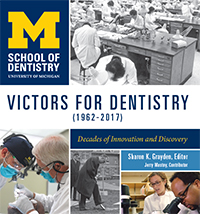
The University of Michigan School of Dentistry - Victors for Dentistry (1962–2017): Decades of Innovation and Discovery
Skip other details (including permanent urls, DOI, citation information): This work is licensed under a Creative Commons Attribution-NonCommercial-NoDerivatives 4.0 International License. Please contact [email protected] to use this work in a way not covered by the license.
For more information, read Michigan Publishing's access and usage policy.
Chapter 7. The Polverini Years (2003–2013)
In February 2003, University of Michigan (U-M) Regents approved the appointment of Dr. Peter Polverini as dean of the School of Dentistry. He assumed the position on June 1, 2003.[1]
Polverini, having just returned to U-M after serving three years as dean at the University of Minnesota, was keenly aware of the school’s world-class reputation and long tradition of quality in all areas of its mission—education, research, and patient care. In conversations with the faculty, staff, students, and alumni, he stressed that his primary goal as dean was to embrace all three mission areas and use existing strengths as the foundation upon which to build a model of dental education, both forward thinking and sustainable.[2] This model would be informed by scientific discovery that would enrich the education students receive and enable them to deliver the very best patient care.
Technology-Enhanced Education
Increasingly, technology was changing how students learned and how faculty taught. Prospective students began to evaluate not just a school’s faculty and its programs, but also its technology and how that technology was being used. A survey of new dental students in the fall of 2002 revealed that slightly more than 40 percent said they owned a laptop computer. Three years later, nearly two-thirds did.[3] Today, all dental students use laptops and various mobile devices.
A new era in preclinical dental education began in the summer of 2003 when the west wing of the old preclinical laboratory was gutted to make way for a new “high-tech clinic.” The renovations, completed in January 2004, were the first updates to that facility since the new dental school was completed in 1969.[4]
The new simulation lab, funded in part by a generous gift from the Roy H. Roberts family, was equipped with 110 workstations where first- and second-year dental students spent many hours learning clinical procedures. Each workstation was set up with a flat-screen monitor to allow students to watch demonstrations of various dental procedures delivered to the screen via video, document camera, the Internet, or other media.
Each workstation was also equipped with a manikin head used to simulate a patient in a dental chair. The manikin setup helped teach correct ergonomic positioning of both patient and clinician as well as the clinical procedures students learn.[4]
The preclinical lab is always part of the tour during the school’s Homecoming Weekend celebration. Many alums have been heard to describe the facility as a technical marvel. Some have even said that many of the materials and techniques dental students were taught would have been science fiction to a new dental student three or four decades ago.
Podcast—2005 Word of the Year
Always ahead of the curve, in 2004, second-year dental student Jared Van Ittersum (DDS 2008) approached the director of Dental Informatics, Dr. Lynn Johnson, and proposed that classroom lectures be recorded so dental students could download lectures to their computers or transfer the information to a laptop or some other portable device. This approach would allow them to review content and listen to the lectures at their convenience anywhere and at any time. This technology was called podcasting and the word “podcast” was tagged by the New Oxford American Dictionary as the 2005 Word of the Year.[5]
noun: A digital audio file made available on the Internet for downloading to a computer or mobile device, typically available as a series, new instalments of which can be received by subscribers automatically.
Working together, the Dental Informatics team and Van Ittersum, launched the podcasting initiative. The School of Dentistry was the first unit on the U-M campus and the first dental school in the country to podcast lectures, both record them and make them available to be downloaded. The student-led initiative was embraced by school administrators and also caught the attention of executives from Apple Computer. In September 2005, Apple Computer executives came to the School of Dentistry to personally congratulate the school for its novel use of technology.[6] Faculty members were given the choice to “opt out” of the lecture capture system, but few did. By the spring of 2007, the number of classroom lectures that dental students could listen to as podcasts surpassed 1,000. Since making this learning option available, dental students have accessed these lectures more than 30,000 times to listen to those lectures.[7]
Outreach Expands—Again
Podcast technology was a tremendous help to dental students on outreach rotations across the state of Michigan. Since the number of outreach sites was growing and the length of time spent at a site was increasing, being able to access lecture content while away from the dental school was hugely important to the students. Appointed as director of outreach and community affairs in 2006, Dr. Bill Piskorowski worked diligently to add more clinics to the outreach milieu. A program that started with two sites, Adrian and Stockbridge, in 1970 eventually grew to 30 sites that included Federally Qualified Health Centers, tribal health authorities, private practices, hospitals, and community clinics. And from a week-long summer experience, time committed to rotations had increased to 3, then 4, and ultimately 12 weeks per student throughout the third and fourth years.
Although the time allotted to community-based clinical outreach experiences has varied over the years, patients across Michigan have consistently benefited from the care they have received. From May 2004 through March 2017, more than 172,000 patients had been seen statewide and nearly 319,250 procedures were performed by U-M dental students with the value of those procedures estimated at more than $38 million.[8]
Developing Future Leaders
The school has a long tradition of producing leaders whether they are students, faculty, or alums. Formal efforts to develop leadership skills among U-M dental and dental hygiene students began in August 2006 with the launch of a new program, the Scholars Program in Dental Leadership. Led by Dr. Russell Taichman, the program brought together a select number of exceptional students from diverse backgrounds to help cultivate a leadership mind-set and nurture skills they would later be able to use to effect change in their profession and in their communities.
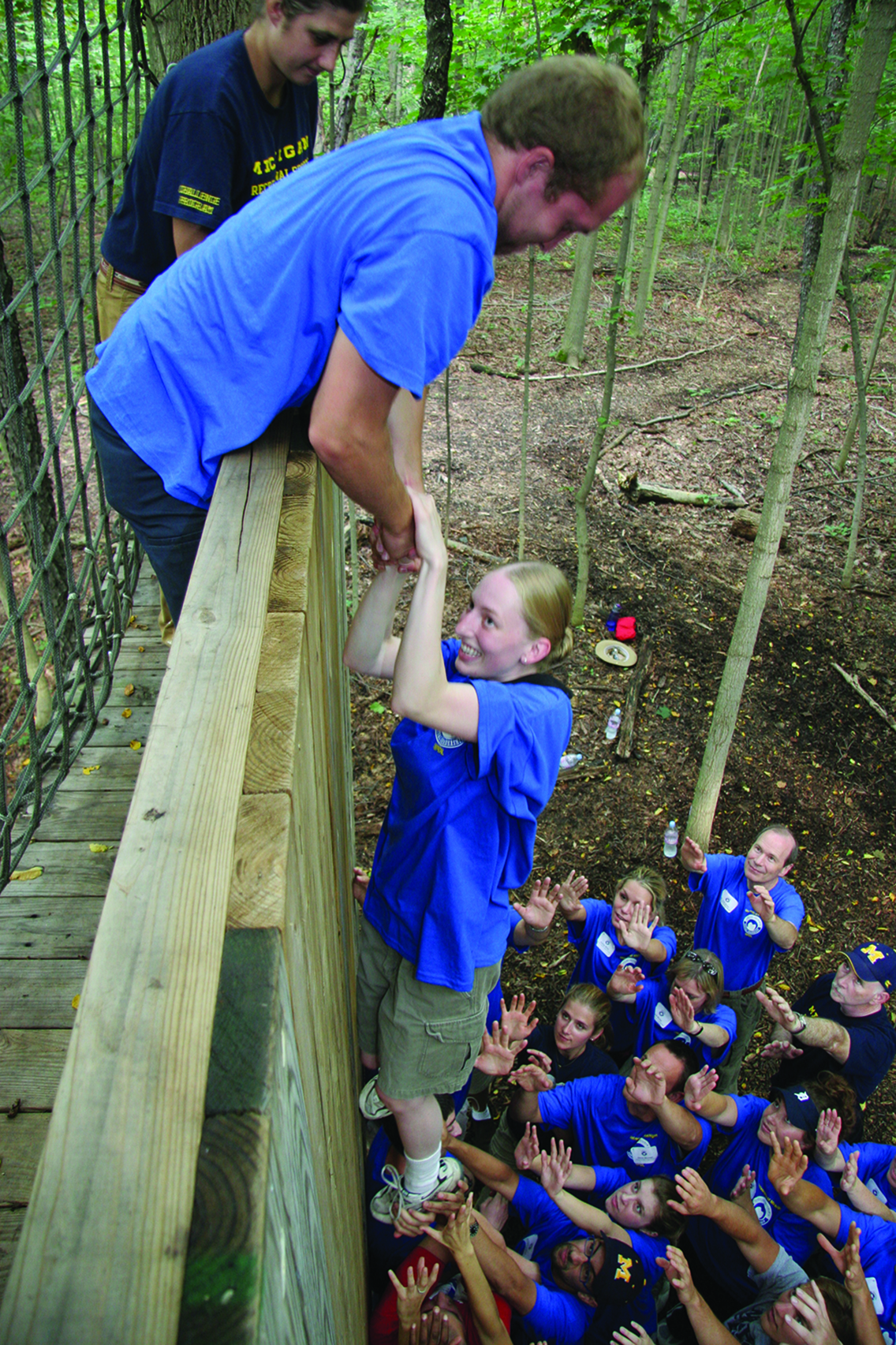
Scholars Program in Dental Leadership (dental scholars) “kicks off” at the University of Michigan “Ropes Course” in August 2006. D1 Ben Anderson helps D3 Erica Scheller reach the top of a 13-foot wall. Below, other students and faculty extend their arms to cushion her if she slips. Goal was to get students to collaborate and devise a plan to get to the top. The wall was a metaphor for the obstacles or challenges they all will face.
Leaders and Best
The School of Dentistry has a long tradition of developing leaders and best in all aspects of dentistry. U-M dental alumni have served as leaders in education, clinical care, research, and professional organizations. And none more prominent than service to the profession through organized dentistry.
Records from the Michigan Dental Association (MDA) show more than 40 U-M graduates serving as MDA president starting in the early 1900s and continuing on through to Michele Tulak-Gorecki (DDS 1990) 2017–2018 term in office. Appendix C has a list of all MDA presidents who are U-M graduates.
Of special note is that three alums rose through the ranks of local and state leadership to reach the pinnacle of professional governance, president of the American Dental Association (ADA). Paul Jeserich (DDS 1924) served as the 1939–1940 MDA president and the 1959–1960 ADA president. Floyd Ostrander (DDS 1934, MS Endodontics 1941) served as the 1956–1957 MDA president and then as the 1967–1968 ADA president. Raymond Gist (DDS 1966) was elected the 2003–2004 MDA president and then ADA president, fulfilling the duties of that esteemed office in the 2010–2011 term.
Jeserich joined the School of Dentistry faculty in 1933. Committed to the highest standards of technical proficiency in clinical dentistry he directed the operative dentistry clinic for 11 years, from 1935 to 1946. In 1937 he assumed responsibility for directing the graduate and postgraduate programs sponsored by the W. K. Kellogg Foundation Institute, a position he held until his retirement. He was appointed dean in 1950 and served in that capacity until stepping down in 1962. He is recognized as an educator dedicated to the professional excellence of all School of Dentistry graduates and for his social concern for the general availability of dental care, working on behalf of the Ann Arbor Veterans Hospital and the Joint Council of the Health Professions to Improve the Health Care of the Aged.
A professor of dentistry for 36 years, Ostrander was a widely known and highly regarded educator. He was an early promoter of the use of fluoride in toothpaste, helped establish endodontics as a specialty, and coauthored the internationally recognized textbook Clinical Endodontics (1956, 1961, 1966). His training as a teacher, proficiency as a clinician, expertise in endodontics, and work with dental therapeutics gained him acclaim as one of the most influential and effective dental educators of his time. He also maintained a private practice in Ann Arbor until he retired in 1981.[9]
Gist was the youngest of eight children—the last born but the first in his family to attend college. Graduation from dental school was celebrated passionately throughout his community and “the pride that I felt from my family and community made me more determined than ever to be successful,” Gist recalled. He went on to note,
Dental school was no cake walk, but after completing the four challenging, intense, fun, and trying years in dental school, I recognized the investment the School of Dentistry had made in me; an investment that set me on a life changing career path.
The skills and values I learned in dental school helped me become an excellent clinician and laid the foundation for the leadership opportunities that followed, culminating in my election to the presidency of the ADA, 43 years after Dr. Ostrander.
Gist was the first African American president of the ADA. As ADA president, Gist was able to travel nationally and internationally. Gist said:
I used my education and experience to promote, advocate, and educate the general public, and policymakers, about the benefits of good oral health and the challenges of providing it for all citizens. I learned that being proactive in gaining and maintaining a position at the forefront of my profession paid significant dividends, and it continues to do so.
Gist, who resides in Grand Blanc, Michigan, continues to serve the School of Dentistry and the university. He is active in the school’s Profile for Success, a program for college students from disadvantaged and underrepresented backgrounds to be successful applicants for dental school. He makes frequent trips to Ann Arbor to work with the DDS students he mentors and to attend meetings of the Board of Directors of the U-M Alumni Association. (Personal Communication, August 2, 2017)
Strategic Assessment and Strategic Imperatives
In 2005, U-M Provost Teresa Sullivan charged all U-M schools and units with the task of conducting a “clear-eyed” evaluation of their intellectual directions and priorities, strengths and weaknesses, comparative advantages over other schools, and value to the university. This charge triggered a significant strategic assessment process that culminated in a comprehensive strategic implementation plan for the School of Dentistry.
The strategic assessment process was led by a committee of 21 faculty, staff, and students. One of the guiding principles was to conduct an inclusive and dynamic systematic review of all School of Dentistry programs, units, and operational issues. The self-assessment took two years to complete and involved nearly every member of the School of Dentistry community. Input was received from internal and external review committees and the outcomes were published in a 27-page report in February 2007 entitled “Strategic Assessment of the School of Dentistry.”
Synthesis of the Strategic Assessment Report formed the basis for the development of a set of strategic imperatives outlining a vision for the future of the dental school. The vision for the future included developing a new model for clinical education, investing in new technology to support the education and clinic programs, targeting growth of the research enterprise, and making a commitment to revitalize the research and patient care facilities.
With the emerging science of genomics and proteomics and the implications this knowledge would have on individualized treatments, it was imperative that dental graduates be prepared for a rapidly changing health-care environment. The key to success would be to develop a model for dental education that established linkages between research, education, and patient care.
Culture and Climate
The School of Dentistry’s leadership has always been very forward thinking in its effort to create a climate in which students, staff, faculty, and patients can interact, learn, work, and be treated in a supportive manner.
This was clearly demonstrated when, in 1973, Dean William Mann established the Office of Minority Affairs, dedicated to the recruitment of diverse students, staff, and faculty. This office evolved into the Office of Multicultural Affairs in 1999, the Office of Multicultural Affairs and Recruitment Initiatives in 2008, and the Office of Diversity and Inclusion since 2014.
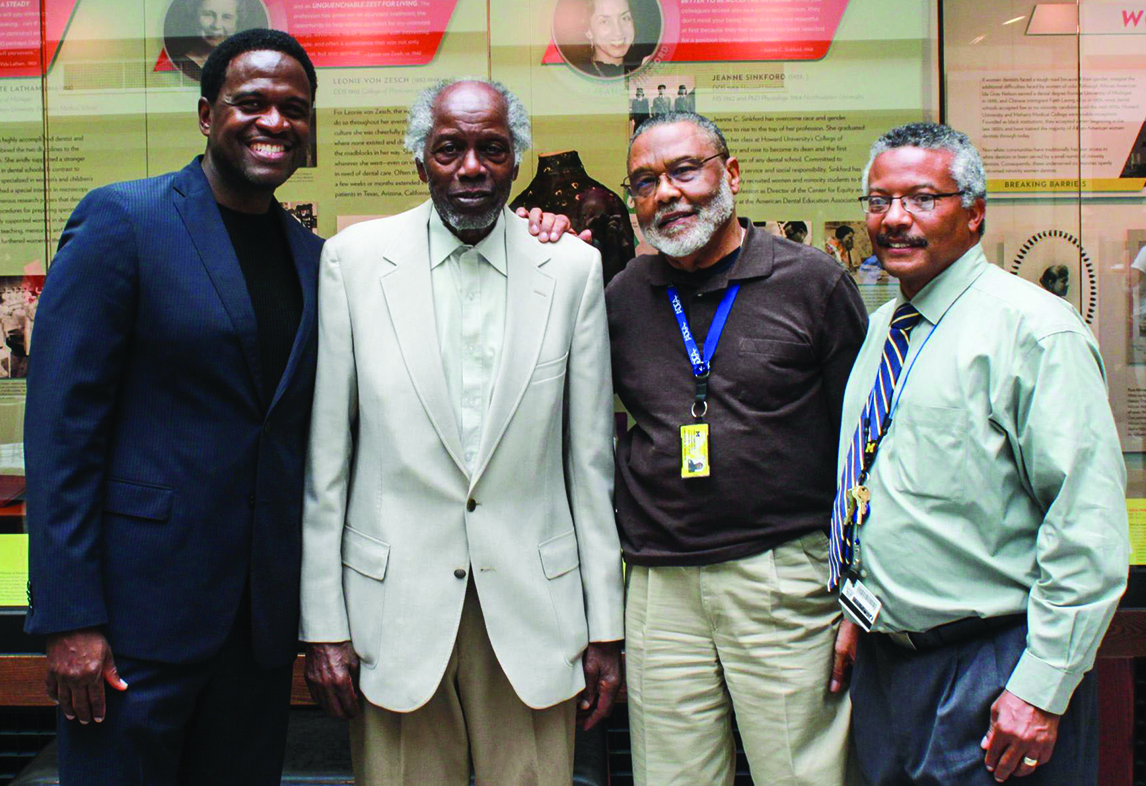
Leaders, past and present, of the school’s diversity and inclusion initiative: Drs. Todd Ester (1999–2006 and 2014–present), Lee Jones (1973–1996), Emerson Robinson (1996–1999), and Kenneth May (2007–2013).
The first school-wide multicultural audit was conducted in 1995. A follow-up audit was completed in 2007 to assess change over time. The outcomes of these audits guided the school leadership in their support of diversity initiatives at all levels (recruitment, retention, education, communication, and work–life balance). The ultimate goals were to ensure diversity, develop cultural competence, and improve the multicultural climate throughout the school.
The Staff Forum
Staff employees are essential to School of Dentistry operations. They are often the unsung heroes who provide invaluable support to the faculty, the leadership, and students as they work to advance the vision and strategic mission of the school.
Over the years, both faculty and student groups had established a way to communicate issues to the dean and other school leaders. Staff employees, however, had no such mechanism. In an effort to ensure an inclusive work environment with open communication to all members of the School of Dentistry community, Dennis Lopatin (senior associate dean) and Tina Pryor (director of human resources) created the Staff Forum. The Staff Forum was formed to bring together a group of staff employees representing a cross section of all departments and units. The mission of the Staff Forum was to help facilitate an environment that promotes professional development and communications to enhance staff morale.
As they listened to the members of the Staff Forum talk about the issues staff were facing, Lopatin and Pryor came up with the idea of hosting a school-wide staff retreat. The first staff retreat was held in the spring of 2007. The half-day session featured a keynote speaker, followed by two or three breakout sessions. It was offered once in the morning and once in the afternoon to accommodate as many of the 330 staff people as possible. Everyone was invited to lunch.

Staff Forum—All Staff Retreat planners Gloria Sdao, Cheryl Quiney, Tina Pryor and Diane Thomas celebrating the success of the retreat.
The retreat was a huge success and feedback featured comments like “it is nice to see that leadership cares about us” and “this event demonstrates that the administration sincerely values our contributions to the School of Dentistry.”
Subsequently, three additional “all staff” retreats were held (2009, 2012, and 2016) and the staff’s participation has been phenomenal. All of the retreats have included sessions targeted at both professional and personal development. Topics offered encourage work life balance and well-being, time management, exercise and relaxation, quality communication, teamwork, meditation/relaxation, building trust and respect, and managing stress.
It is important to note that the School of Dentistry was the first school or college to host this type of “all school” staff activity on the U-M campus.
Building a New Curriculum
To ensure that the school was going to remain among “the leaders and the best,” the school leadership team determined that tackling the DDS curriculum was an important priority. All agreed it was time to update the curriculum with more contemporary educational strategies, strategies that would expand the students’ experiences and enrich learning while simultaneously enhancing clinical knowledge to enable students to deliver the highest quality, patient-centered oral health care to an increasingly diverse and multicultural population.
Of significance was the belief that rapid advancement of scientific discovery and the desire to translate these findings to improved health care required a knowledge base that was well beyond what current dental graduates were expected to know. Therefore, the new curriculum would integrate science and clinical practice throughout all four years of dental school and new pedagogical methods to foster integration would be developed.
The need for a deeper understanding of the scientific underpinnings of dentistry was just one piece of the puzzle. There was also the need to cultivate critical thinking and decision-making skills in all aspects of dental care. There was also a strong desire to offer a curriculum with flexible learning tracks providing expanded professional opportunities.

Graphic from page 9, “Report to the School of Dentistry Community” prepared by the Vision Implementation Team.
A Vision Implementation Team (VIT) was formed in 2008 and was charged to put in place a structure and path to enable faculty members to develop a new curriculum model that included (a) an enhanced teaching and learning environment that results in student independent decision-making and critical thinking, (b) development of new, flexible learning pathways that provide for expanded professional opportunities, and (c) better use of limited financial resources in the future. The VIT’s major role was to facilitate planning and implementation of the vision by the faculty.
Members of the VIT were Paul Krebsbach (chair, Biologic and Materials Sciences, team chair), Stephen Bayne (chair, Cariology, Restorative Sciences and Endodontics), Dennis Lopatin (senior associate dean), Charlotte Mistretta (research dean), Jacques Nör (Cariology, Restorative Sciences and Endodontics), and Phil Richards (Periodontics and Oral Medicine). The team met faithfully every week for almost two years with a focus on developing a new curriculum. Their diligence and dedication delivered a new, innovative curriculum designed to produce a graduate grounded in scientific evidence, able to apply critical thinking and problem-solving skills in all aspects of oral health-care delivery—diagnosis, risk assessment, treatment planning, and clinical care.
The New Curriculum Launches
In July 2010, the new, innovative dental curriculum was launched and introduced changes in preclinical instruction, earlier clinical experiences, opportunities for students to explore more career path options, greater collaboration with faculty, and more exposure to scientific knowledge needed in providing patient care. At the time, traditional dental curricula were linear in their staged presentation of basic science, clinical science, clinical procedures, clinical practice, and electives. The new curriculum started all of these phases simultaneously and carried them throughout the entire four-year experience.
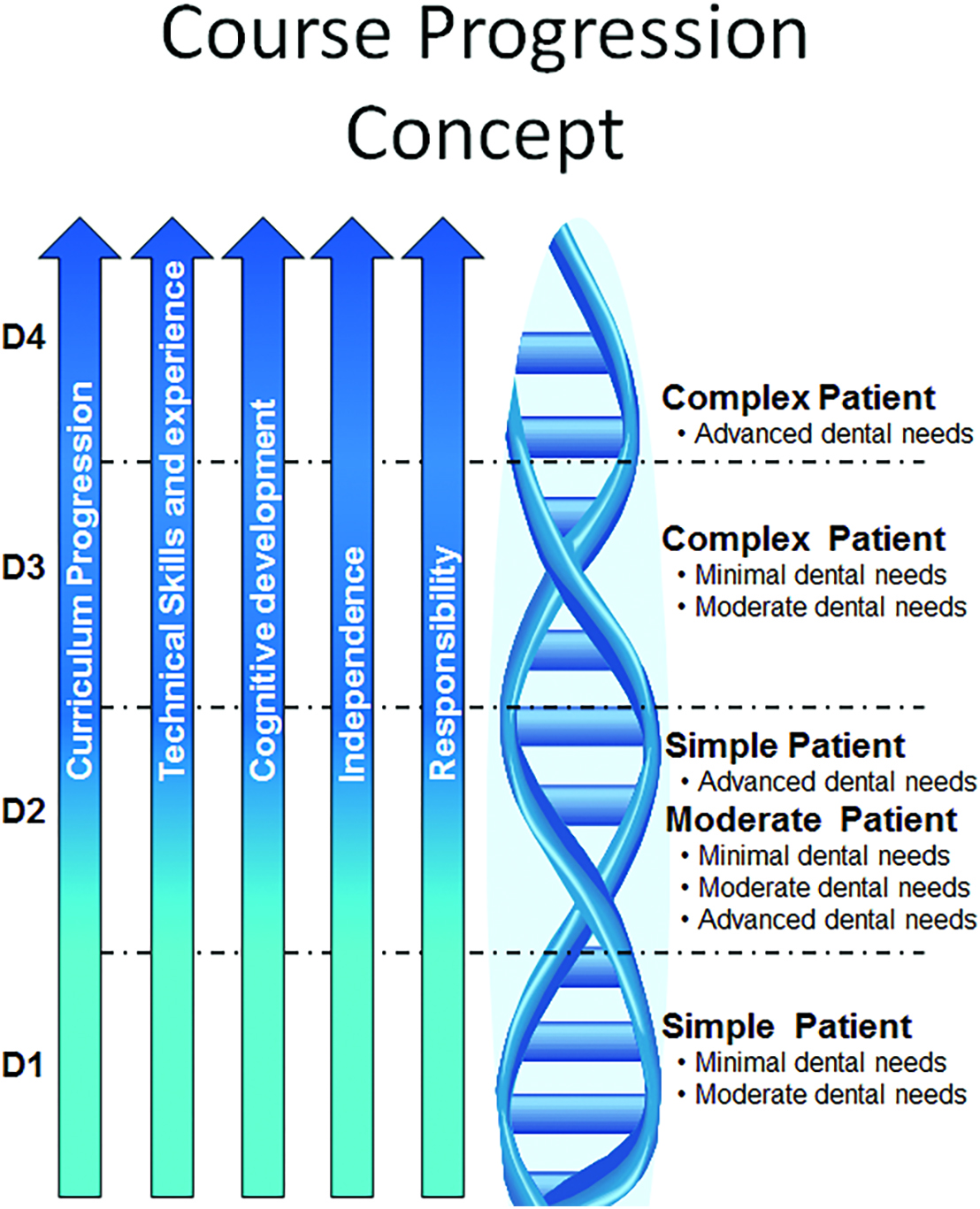
Patient care progresses in levels of difficulty as students advance through the curriculum. Graphic from page 22,”Report to the School of Dentistry Community” prepared by the Vision Implementation Team.
This integrated approach reinforced basic sciences with clinical content and introduced patient care experiences in the first year. At the same time, dental students were able to select a special area of interest or career path to explore in depth. In addition, a new concept called “flexible time” was built into each week. Flexible time was unscheduled time provided to students to allow them to absorb information conveyed in classrooms and clinics as well as facilitate opportunities to foster greater interaction among their colleagues and faculty.[10]
The Pathways Program
The Pathways program offered every dental student a framework from which to explore a topic of personal interest in one of three distinct areas—health-care delivery, leadership, and research. Students work with faculty throughout their four years in dental school and engage in different types of scholarship through supplemental learning opportunities and capstone projects, depending on which pathway they choose. The program culminates with a special Pathways Day program where D4 students present summaries of the projects they have completed.
The first Pathways Day program was held in 2014 with the students presenting oral and poster summaries of their project and featured Ari Weinzweig (Zingerman’s cofounder) as the keynote speaker.
Dental Hygiene E-Learning
The use of technology to enhance education took a big step forward in January 2008 when the school launched its first online degree completion program leading to a Bachelor of Science in dental hygiene. Eight students enrolled in the first cohort. The e-learning program attracted interest across U-M and from other colleges and universities worldwide. Dental hygiene students from around the country who earned an associate’s degree or certificate were now able to take online courses at home or elsewhere, at their convenience, to earn a Bachelor of Science degree.[11][12]
The success of this program led to the development of a second online learning program, a Master of Science degree in dental hygiene, a two-year, six-semester course of study totaling 36 credit hours offered by the Rackham Graduate School in conjunction with the School of Dentistry. Professor Wendy Kerschbaum, director of the dental hygiene curriculum, said, “The online bachelor’s degree program gave us a solid foundation that helped us to develop the master’s program.”[13]
Electronic Patient Records
With the success of the transition from paper to an all-electronic environment in the orthodontic clinic, the school continued to embrace the electronic age when 160 computers were installed in the comprehensive care clinics (the VICs) on the second and third floors so that special software delivered patient information chairside with the touch of a few keystrokes. This advancement marked the fusion of innovation in technology, dental education, and patient care. The paper-to-digital transition was celebrated with a “floss-cutting ceremony” attended by U-M Provost Teresa Sullivan in June 2008.[14]
The Dental Library Transforms
Since its founding, the dental library had always had its home in the School of Dentistry building. But things were rapidly changing. Libraries and librarians were among the first to embrace the information age using computer searches to assist faculty and students in their quest to locate materials available online. With the prevalence of digital content and electronic access to the content, many of the dental library’s holdings were also digitized. In 2008, it was decided to merge the dental library with the Taubman Medical Library (renamed the Taubman Health Sciences Library in April 2010) and house both contemporary and historical holdings there. Much of dentistry’s content is available online and those items physically stored at the health sciences library are conveniently accessible to researchers and others near and far.
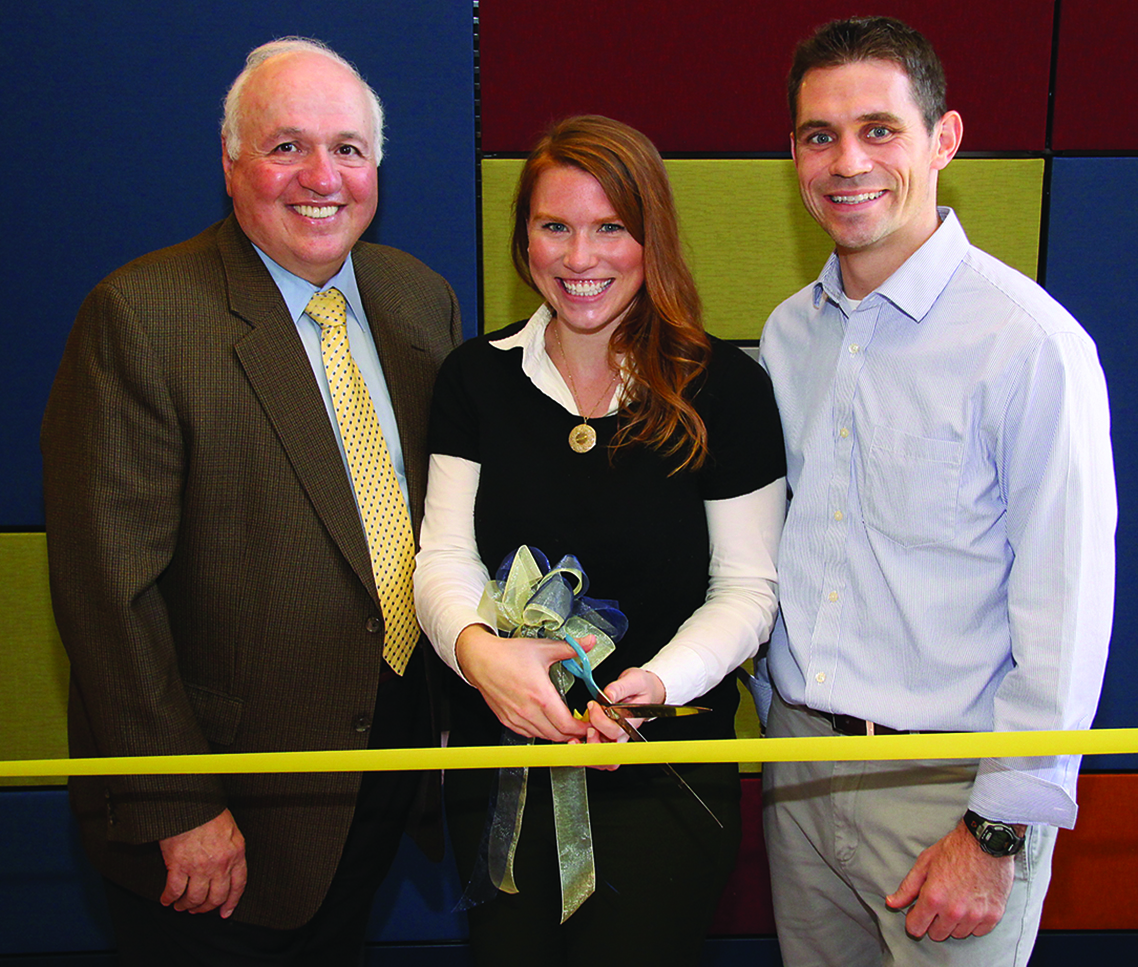
Dean Peter Polverini joins Emily Kennedy (DDS 2013) and Aaron Ruhlig (DDS 2014) for the ribbon-cutting ceremony marking the opening of “The Commons” study area.
Not only was the library a repository for books, journals, course materials, and other reference items, it was also a great place for students to go to study. Students expressed concern that they had now lost their quiet study area. Responding to the students’ concern, the library space was reconfigured, refurnished, and renamed “The Commons” in 2012. It is a very popular study space for students and also serves as home for the school’s Human Resources Service Center.
Old Technology, New Format
The school found new ways to use educational videos made in its television studios during the 1970s. More than 1,000 videos were changed to a digital format and became a part of the Open Michigan initiative designed to share the university’s and the school’s knowledge, resources, and research worldwide. The videos are a part of the university’s YouTube Channel (www.youtube.com/user/umichdent).[15] According to Dan Bruell, director of the school’s Digital Learning Services unit, by the fall of 2015, the videos had been viewed more than 20 million times worldwide. The most viewing occurred in the United States (28%), followed by India (10%), the United Kingdom (3.5%), Canada (3.5%), and Saudi Arabia (2.9%). The most watched video has been “Removal of Carious Lesions,” viewed nearly 1.4 million times.
Global Initiatives
The school formally committed to international outreach when the Global Oral Health Initiative program was created in 2011, and Dr. Yvonne Kapila was named program director. This new program was established to parallel U-M President Mary Sue Coleman’s Third Century Initiative that sought to develop new avenues of learning and immerse students in experiences beyond campus classrooms. The school’s initial efforts were sharply focused and built on established relationships in Ghana, Kenya, and Brazil. Over the years, many dental students have said participating in an international outreach experience has been the highlight of their four years of dental studies at Michigan.
Interprofessional Education
Interprofessional education gained momentum during this time. Beginning in early 2012, school administrators and faculty led discussions with those from other units on campus to explore and implement a new approach to education. This approach encouraged all of the health sciences schools to rethink the traditional “siloed” method of education and patient care. Instead, the schools were encouraged to develop programs that involved students from multiple health-care professions—medicine, dentistry, public health, nursing, pharmacy, and social work—learning with, about, and from each other. One of the early pilots of this approach was implemented that summer. Students in the School of Nursing’s Second Career Bachelor of Science program shadowed dental students, residents, and faculty dentists in the dental school’s pediatric dentistry clinic. The dental course was added to the School of Nursing’s curriculum to familiarize nurses about oral health-care issues they may encounter in patients they see in various patient care situations.[16]

As part of the interprofessional education initiative, Dr. Gail Czarnecki, clinical assistant professor, Department of Orthodontics and Pediatric Dentistry, developed a dental-focused program to allow nursing students to shadow dental students, residents, and faculty dentists in the pediatric dental clinic.
Research Enterprise Flourishes
This era was marked by significant research grants from the National Institute of Dental and Craniofacial Research (NIDCR). Pat Schultz, administrative manager of the Office of Research and Training, said:
Our research awards have been impressive. . . . During the 10 years from 2004 to 2013, NIDCR annually awarded the school between $8.6 million and $11.4 million for research. In three of those years (2006, 2009, 2011), the school ranked first among all dental schools in the country receiving awards. In four years (2004, 2005, 2008, 2013) the school ranked second. In 2007 and 2012, it ranked third. (Personal Communication February, 17, 2014)
Polverini said the awards were vital because research leads to discoveries that have the potential to benefit practitioners and their patients while also helping to advance the dental profession.[17] Collaborative research with other units on campus gained momentum when the school moved some of its research facilities to the North Campus Research Center in August 2012.
Reflections
The Polverini era was a time of curricular change and transformation, and an expansion of technology used for teaching and data management. It was also at the time that saw significant growth of the research enterprise. A dynamic and determined faculty and staff committed to a new model for dental education that became a model for dental schools around the world endeavor to emulate.
Polverini received one of U-M’s top honors in May 2015 when he was named the Jonathan Taft Distinguished University Professor of Dentistry. Distinguished University Professorships recognize individuals for major contributions to the university, the nation, and the world and for exceptional scholarly and/or creative achievements, national and international reputation, superior teaching and mentoring, and an impressive record of service.[18]


























